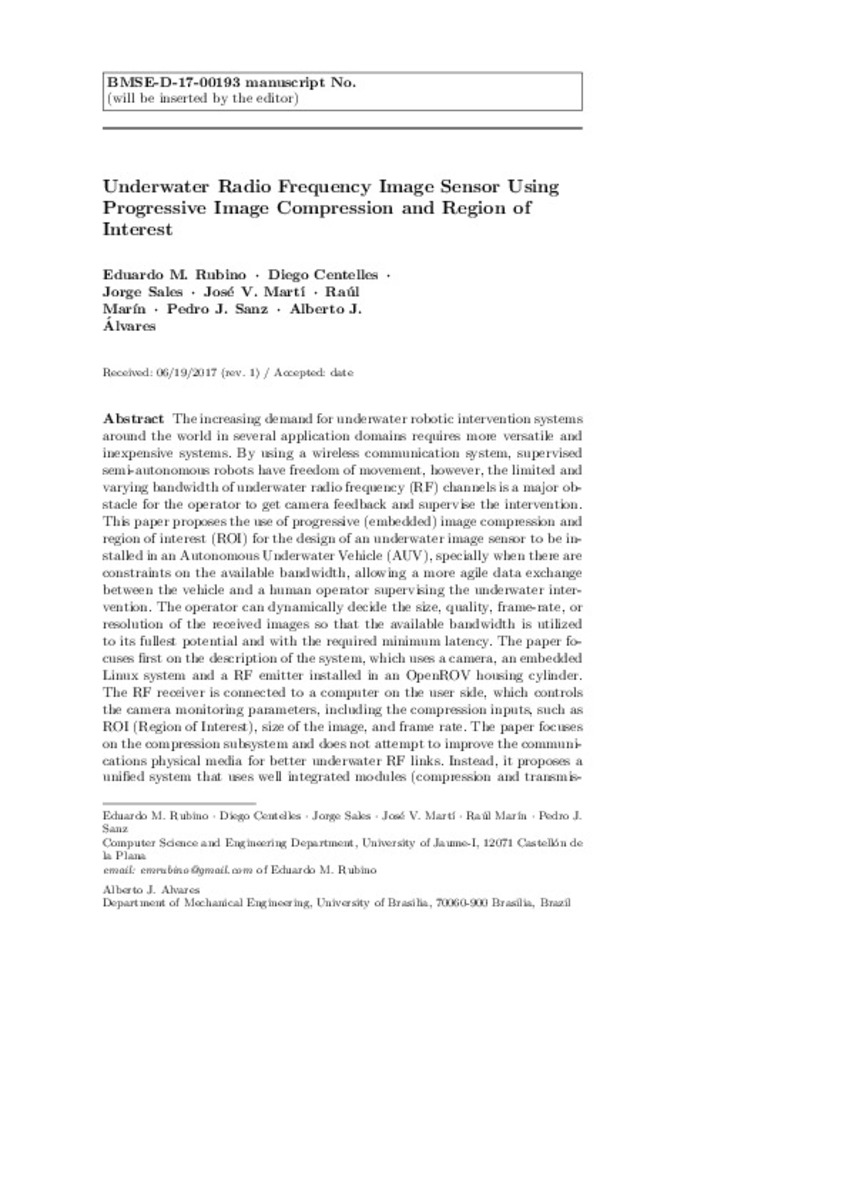Mostra el registre parcial de l'element
Underwater radio frequency image sensor using progressive image compression and region of interest
| dc.contributor.author | Moscoso Rubino, Eduardo | |
| dc.contributor.author | Centelles, Diego | |
| dc.contributor.author | Sales Gil, Jorge | |
| dc.contributor.author | Martí Avilés, José Vicente | |
| dc.contributor.author | Marin, Raul | |
| dc.contributor.author | Sanz, Pedro J | |
| dc.contributor.author | Alvares, Alberto | |
| dc.date.accessioned | 2018-03-02T10:30:33Z | |
| dc.date.available | 2018-03-02T10:30:33Z | |
| dc.date.issued | 2017-08 | |
| dc.identifier.citation | RUBINO, Eduardo M., et al. Underwater radio frequency image sensor using progressive image compression and region of interest. Journal of the Brazilian Society of Mechanical Sciences and Engineering, 2017, vol. 39, no 10, p. 4115-4134. | ca_CA |
| dc.identifier.uri | http://hdl.handle.net/10234/173140 | |
| dc.description.abstract | The increasing demand for underwater robotic intervention systems around the world in several application domains requires more versatile and inexpensive systems. By using a wireless communication system, supervised semi-autonomous robots have freedom of movement; however, the limited and varying bandwidth of underwater radio frequency (RF) channels is a major obstacle for the operator to get camera feedback and supervise the intervention. This paper proposes the use of progressive (embedded) image compression and region of interest (ROI) for the design of an underwater image sensor to be installed in an autonomous underwater vehicle, specially when there are constraints on the available bandwidth, allowing a more agile data exchange between the vehicle and a human operator supervising the underwater intervention. The operator can dynamically decide the size, quality, frame rate, or resolution of the received images so that the available bandwidth is utilized to its fullest potential and with the required minimum latency. The paper focuses first on the description of the system, which uses a camera, an embedded Linux system, and an RF emitter installed in an OpenROV housing cylinder. The RF receiver is connected to a computer on the user side, which controls the camera monitoring parameters, including the compression inputs, such as region of interest (ROI), size of the image, and frame rate. The paper focuses on the compression subsystem and does not attempt to improve the communications physical media for better underwater RF links. Instead, it proposes a unified system that uses well-integrated modules (compression and transmission) to provide the scientific community with a higher-level protocol for image compression and transmission in sub-sea robotic interventions. | ca_CA |
| dc.format.extent | 19 p. | ca_CA |
| dc.format.mimetype | application/pdf | ca_CA |
| dc.language.iso | eng | ca_CA |
| dc.publisher | Springer-Verlag | ca_CA |
| dc.rights | © The Brazilian Society of Mechanical Sciences and Engineering 2017 | ca_CA |
| dc.rights.uri | http://rightsstatements.org/vocab/InC/1.0/ | * |
| dc.subject | progressive image compression | ca_CA |
| dc.subject | region of interest (ROI) | ca_CA |
| dc.subject | wavelet transforms | ca_CA |
| dc.subject | low-bandwidth communications | ca_CA |
| dc.subject | underwater vehicles for intervention | ca_CA |
| dc.title | Underwater radio frequency image sensor using progressive image compression and region of interest | ca_CA |
| dc.type | info:eu-repo/semantics/article | ca_CA |
| dc.identifier.doi | https://doi.org/10.1007/s40430-017-0894-6 | |
| dc.relation.projectID | Spanish Ministry (Grant DPI2014-57746-C3) (MERBOTS Project) ; Universitat Jaume I (Grants PID2010-12, E-2015-24, PREDOC/2012/47 and PREDOC/2013/46) ; Generalitat Valenciana (Grant ACIF/2014/298) ; Brazil CNPQ and FAP/DF | ca_CA |
| dc.rights.accessRights | info:eu-repo/semantics/openAccess | ca_CA |
| dc.relation.publisherVersion | https://link.springer.com/article/10.1007/s40430-017-0894-6#Abs1 | ca_CA |
| dc.type.version | info:eu-repo/semantics/submittedVersion | ca_CA |
Fitxers en aquest element
Aquest element apareix en la col·lecció o col·leccions següent(s)
-
ICC_Articles [417]







